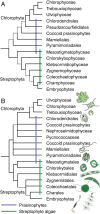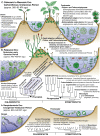Streptophyte algae and the origin of embryophytes
- PMID: 19273476
- PMCID: PMC2707909
- DOI: 10.1093/aob/mcp044
Streptophyte algae and the origin of embryophytes
Abstract
Background: Land plants (embryophytes) evolved from streptophyte green algae, a small group of freshwater algae ranging from scaly, unicellular flagellates (Mesostigma) to complex, filamentous thalli with branching, cell differentiation and apical growth (Charales). Streptophyte algae and embryophytes form the division Streptophyta, whereas the remaining green algae are classified as Chlorophyta. The Charales (stoneworts) are often considered to be sister to land plants, suggesting progressive evolution towards cellular complexity within streptophyte green algae. Many cellular (e.g. phragmoplast, plasmodesmata, hexameric cellulose synthase, structure of flagellated cells, oogamous sexual reproduction with zygote retention) and physiological characters (e.g. type of photorespiration, phytochrome system) originated within streptophyte algae.
Recent progress: Phylogenetic studies have demonstrated that Mesostigma (flagellate) and Chlorokybus (sarcinoid) form the earliest divergence within streptophytes, as sister to all other Streptophyta including embryophytes. The question whether Charales, Coleochaetales or Zygnematales are the sister to embryophytes is still (or, again) hotly debated. Projects to study genome evolution within streptophytes including protein families and polyadenylation signals have been initiated. In agreement with morphological and physiological features, many molecular traits believed to be specific for embryophytes have been shown to predate the Chlorophyta/Streptophyta split, or to have originated within streptophyte algae. Molecular phylogenies and the fossil record allow a detailed reconstruction of the early evolutionary events that led to the origin of true land plants, and shaped the current diversity and ecology of streptophyte green algae and their embryophyte descendants.
Conclusions: The Streptophyta/Chlorophyta divergence correlates with a remarkably conservative preference for freshwater/marine habitats, and the early freshwater adaptation of streptophyte algae was a major advantage for the earliest land plants, even before the origin of the embryo and the sporophyte generation. The complete genomes of a few key streptophyte algae taxa will be required for a better understanding of the colonization of terrestrial habitats by streptophytes.
Figures


References
-
- Ariel FD, Manavella PA, Dezar CA, Chan RL. The true story of the HD-Zip family. Trends in Plant Science. 2007;12:419–426. - PubMed
-
- Bateman RM, Crane PR, DiMichele WA, et al. Early evolution of land plants: phylogeny, physiology, and ecology of the primary terrestrial radiation. Annual Review of Ecology and Systematics. 1998;29:263–292.
-
- Becker B, Hoef-Emden K. Evolution of vacuolar targeting in algae. Botanica Marina. 2009 (in press). doi:10.1515/BOT.2009.013.

